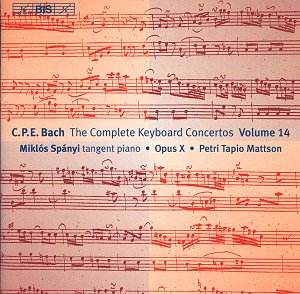Well, raise your hands all those who
have all of the earlier thirteen volumes.
Now raise your hands those who had gone
for the solo keyboard works which Bis
has been bringing out for the last decade?
If you have, well done. You have seen
an ever burgeoning series improving
in every respect. You are also probably
running out of shelf space and there
are still quite a few of them to go.
They have been improving from a scholarly
point of view, improving musically;
perhaps developing is a better word.
In any event the approach has not stood
still. Those involved have always been
looking at how things could be made
more interesting and valuable.
The whole project has
really been the brain-child of Miklos
Spanyi who often writes the booklet
notes and features as an executant on
each disc. In volume one Rachel Wade
in her notes told us that there are
fifty-two concertos dating from 1733.
That was the year allotted to the G
major concerto (W3) recorded on volume
one. The concerto was written when Bach
was about nineteen. Not all of the concertos
were originally written for keyboard;
some were for cello or flute or indeed
double concertos. C.P.E. made arrangements
of them for keyboard, and others, like
the A minor concerto, may have been
arranged by another hand.
Anyway if you have
been buying this series then no further
introduction is necessary, but perhaps,
like me you have purchased a few or
perhaps you are just inquisitive. So
let’s go back ten or eleven years.
I can remember a decade
ago trying to find recordings of C.P.E.
Bach’s keyboard concertos. I had read
that he had made a major contribution
to the genre, at about the same time
as and immediately before Mozart. My
sources indicated that his contribution
was "very significant" (Grove)
yet I found only a handful of works.
Quite out of the blue this Bis series
started up.
There are and were
other possible discs and comparable
performances. I should just mention
those I purchased at the time and which
are still available. There is a double
disc set of the six concertos Wq 43
played by Bob Van Asperen on Virgin
(VCD 545094 2). That was originally
recorded in 1984. There are also two
separate discs on CPO played by Ludger
Remy (999 350-2 and 999 566-2). All
of these works are from the 1750s and
1760s. As one might expect, a reconstructed
harpsichord is used.
The present Bis series
set about recording the concertos in
chronological order. To the main concerto
sequence Bis adds the works called by
C.P.E. ‘Sonatinas’ for keyboard and
string orchestra.
Spanyi having used
the fortepiano from volume four has,
since about volume six, moved onto using
a fascinating and rare instrument: the
tangent piano. This instrument, which
was invented c.1705, resembles a harpsichord
and an early piano in design. It normally
features five octaves of keys and the
strings are struck by a narrow wooden
or metal slip instead of being depressed.
Christoph Schroter discovered this by
letting blank harpsichord jacks hit
the strings, but dampers are also incorporated.
It is important that
the recorded balance is maintained throughout
the dynamic range of the instrument.
Also important is forward placing in
the sound spectrum and having an the
accompanying orchestra sensitive to
the needs of the music. This was not
always the case in the earlier volumes
(perhaps Vol. 11) but here the results
are excellent and a pleasure to listen
to.
From volume eight Spanyi
used an instrument built in 1993 by
Ghislein Porvlieghe. He also recorded
with ‘Concerto Armonico’ in Budapest
on period instruments. This new volume
has moved the project to Finland and
to a new ensemble named Opus X. They
are a slightly smaller group of eleven
musicians including four violin players.
Spanyi also has a new tangent piano,
a less decorative one, according to
the accompanying picture. It is warmer-sounding
- a less brittle instrument - and was
made in 1998 by Potvlieghe. Spanyi writes
about this change in a fascinating booklet
essay following Jane Stevens’ equally
interesting essay about C.P.E.’s influence
upon his brothers and with some detailed
analysis of the three works.
The characteristics
of C.P.E. that we have come to expect
are to the fore especially in the A
minor concerto. These include dramatic
contrasts in sound between soloists
and accompanying instruments with sudden
dynamic changes. Surprise and inventiveness
are essential elements in the part-writing
and there is an impatient tendency to
develop a musical idea nearly as soon
as it is heard. Also notable is the
use of unusual modulatory passages.
The E flat concerto
uses these characteristics less than
most of the other concertos I have heard
so far. Here the emphasis is on grace
and melody. That may be because it is
a much later work when the style changed
from the heavier, rather twisted baroque
to the ‘style galante’ of C.P.E.’s younger
brother J.C. Bach whose music had been
in popular circulation for a few years.
Here was music of refined and thin-webbed
sensitivity. The first movement which
is really a minuet-cum-Sarabande is
especially delightful to start with,
before going into its typically more
jagged, dotted rhythms.
The Sonatina is a lighter
work anyway. However all three works
here have three movements with the Sonatina
beginning with a Larghetto. Then follows
an Allegro and a concluding ‘alla polacca’.
Taking another example, the Sonatina
in F, recorded on Volume 13, BIS-CD-1307,
also started with a slow movement and
ended in a dance-like Allegretto. In
this music the young spirit of Mozart
can be felt near at hand in the wings.
If you are collecting
this series then I need say little else.
If you want to sample then I can seriously
recommend that this disc would make
an excellent place to start.
Gary Higginson


